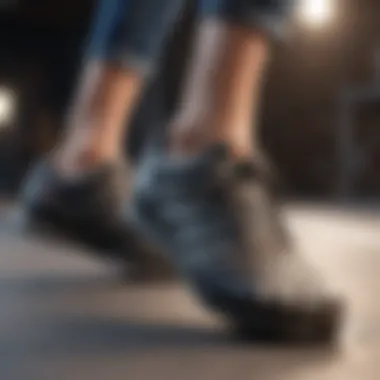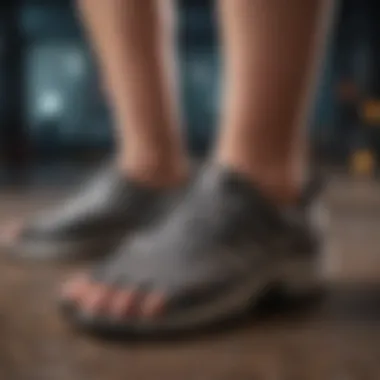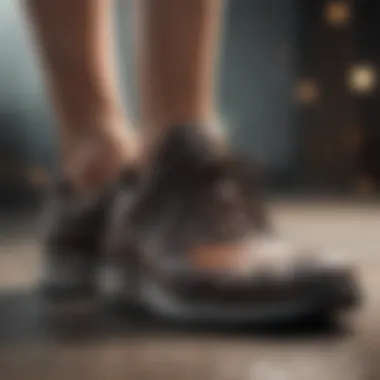Best Shoes for Toe Problems: A Comprehensive Guide


Intro
Foot-related issues often stem from common conditions such as bunions, hammertoes, and plantar fasciitis. These problems can cause significant discomfort and, when left unaddressed, may lead to further complications or chronic pain. Understanding these concerns is crucial, not only for those suffering but also for health professionals and caregivers who guide patients toward effective solutions. This narrative will explore the optimal shoes designed to alleviate toe-related discomfort.
By examining various toe problems and their specific needs, we can identify essential features to look for in footwear. Supportive shoes should provide adequate cushioning, proper arch support, and a roomy toe box to prevent aggravation of existing conditions. We will also review specific models known to aid in discomfort relief and foot health.
Well-being is not just about comfort. It is about enhancing daily life and preventing any conditions from worsening. Proper footwear plays a vital role in this equation. It is imperative to foster awareness surrounding toe issues, thus helping individuals make educated footwear choices that align with their needs.
From here, we will systematically break down the discussed aspects, analyze shoe designs, and consider preventive strategies. The aim is to provide a comprehensive guide that informs decisions related to foot health and well-being.
Understanding Toe Problems
Understanding toe problems is crucial for making informed decisions regarding footwear that can alleviate pain and discomfort. This section aims to shed light on the various toe conditions individuals might face, along with their underlying causes. Knowledge of these factors can guide the choice of appropriate shoes, which is essential in managing toe problems. When people understand the nuances behind their conditions, they can select shoes that not only provide comfort but also support healing and prevent further complications.
Common Toe Conditions
Bunions
Bunions are a common foot issue that involve a bony bump at the base of the big toe. This deformity emerges when the big toe pushes against the next toe, causing the joint to stick out. They can be both painful and unsightly, often leading to a decrease in foot function. Shoes that offer a wider toe box can ease pressure on the bunion, making them a recommended choice for individuals with this condition. Furthermore, specialized bunion shoes often feature soft, stretchy materials that prevent irritation and provide added comfort.
Hammertoes
Hammertoes occur when the middle joint of a toe bends downward, resembling a hammer. This condition can cause discomfort and problem with finding suitable footwear. Individuals with hammertoes often struggle with shoes that do not accommodate the bent posture of their toes. Selecting footwear with extra room in the toe area can minimize friction and allow for proper alignment. Additionally, shoes with adjustable straps can offer a tailored fit, which can be very beneficial.
Plantar Fasciitis
Plantar fasciitis is characterized by sharp heel pain that usually occurs with the first steps in the morning or after prolonged periods of sitting. This condition results from inflammation of the plantar fascia, the thick band of tissue that runs across the bottom of the foot. Supportive footwear is essential for individuals suffering from plantar fasciitis, as shoes that provide ample arch support and cushioning can significantly reduce discomfort. Optimal shoe choices often include well-cushioned insoles and midsole support features.
Morton's Neuroma
Morton's neuroma involves the thickening of nerve tissue between the toes, often causing sharp pain and a burning sensation. This condition typically affects the area between the third and fourth toes. Choosing shoes with ample cushioning and a wide toe box can alleviate symptoms. Brands that focus on comfort often offer models that relieve pressure on the nerve and enhance overall shoe fit. Understanding the features that reduce foot stress is crucial for anyone dealing with this condition.
Ingrown Toenails
Ingrown toenails occur when the edges of the toenails grow into the surrounding skin. This can lead to pain and sometimes infection. Shoes that are too tight can exacerbate this issue, therefore, it is vital to select footwear that provides ample room for toes to move freely. Soft, breathable materials can also help avoid irritation and promote healing. Options such as sandals or well-fitted shoes with soft fabrics are often recommended for those affected.
Causes of Toe Problems
Genetics
Genetics play a significant role in predispositions to various toe conditions. Certain foot shapes and inherited characteristics can increase the chance of developing issues such as bunions or hammertoes. This genetic aspect is why some individuals may experience toe problems while others do not. Knowing one's family history can guide preventive measures and shoe choices.
Inappropriate Footwear
Inappropriate footwear is a major contributing factor to toe problems. Shoes that are ill-fitting, overly tight, or lack support can lead to significant discomfort and foot deformities over time. It is essential to invest in well-fitted shoes that provide adequate space in the toe box. The selection of proper footwear is critical for avoiding exacerbation of existing issues or the development of new conditions.
Foot Structure
Each individual has a unique foot structure, including arch height and toe alignment, which can affect the development of toe problems. Individuals with flat feet or high arches may be more susceptible to conditions such as plantar fasciitis. Understanding one’s foot structure can be beneficial in selecting shoes that offer appropriate support, therefore improving overall foot health.
Occupational Hazards
Occupational hazards can contribute to the development of toe issues, especially in jobs that require standing for long periods or wearing restrictive footwear. Professions such as nursing, retail, or construction often expose individuals to conditions that influence foot health. Identifying job-related risks can help in selecting suitable footwear that mitigates these hazards, which is essential for long-term foot care.
Aging
As individuals age, changes in the foot structure often occur, leading to an increased risk of toe problems. Ligaments and tendons lose elasticity, and the fat pad on the soles of the feet thins, making older adults more prone to discomfort. Acknowledging the effects of aging emphasizes the importance of proper footwear choices that can provide stability and support, which can enhance mobility and overall toe health.
Criteria for Choosing Shoes


Choosing the right shoes is essential for individuals facing toe problems. Proper footwear can alleviate discomfort and promote better foot health. It involves evaluating several criteria to ensure the footwear effectively addresses specific conditions. In this section, we will explore the vital elements to consider when selecting shoes to help manage toe issues. These criteria include arch support, toe box space, cushioning mechanics, material quality, and sole flexibility. Each aspect contributes significantly to comfort and overall foot well-being.
Arch Support
Arch support is a fundamental feature in shoes that helps distribute body weight evenly across the feet. Adequate arch support prevents excessive pressure on the toes, which can worsen conditions such as bunions or hammertoes. When choosing shoes, look for models that offer targeted support. This helps in maintaining foot alignment and reduces strain on ligaments and muscles.
People with flat feet or high arches may require different types of support. Shoes designed with contoured insoles provide better arch stability. Therefore, investing in footwear that specifically addresses your arch type is vital for long-term benefits.
Toe Box Space
The toe box is the front section of the shoe where the toes reside. A proper fit in this area is crucial for comfort in individuals with toe problems. Shoes with a roomy toe box allow for natural toe splay and reduce the risk of friction and pressure. This is particularly important for those with bunions or hammertoes, as tight shoes can aggravate these issues.
When trying on shoes, ensure that there is enough space to wiggle your toes without feeling constricted. A shoe with an adequately sized toe box can significantly enhance comfort levels.
Cushioning Mechanics
Cushioning mechanics play a key role in the shock absorption provided by footwear. Shoes with good cushioning help minimize impact on the feet during various activities. For instances like plantar fasciitis, effective cushioning can reduce stress on the heel and arch.
Look for shoes that incorporate advanced cushioning technologies such as gel inserts or foam midsoles. These features can promote a more comfortable walking experience and assist in alleviating pain associated with various toe conditions.
Material Quality
The quality of materials used in the construction of shoes influences durability and comfort. Breathable materials help in moisture management, keeping the feet dry and reducing the risk of infections. Sturdy yet flexible uppers allow for natural foot movement while providing necessary support.
When selecting shoes, consider investing in well-constructed options. High-quality materials enhance the longevity of the footwear and contribute to overall foot health.
Sole Flexibility
Sole flexibility refers to how easily the shoe bends and moves with the foot during activity. Shoes that are too stiff can restrict natural movement and lead to discomfort in toe problems. On the contrary, shoes with an appropriate degree of flexibility improve gait dynamics and reduce fatigue.
It is essential to test how the shoes bend at the forefoot when shopping. A flexible sole can allow for better function, especially for toe-related conditions.
Ultimately, the right shoes can serve as a foundation for foot health, making the careful selection of features paramount for individuals dealing with toe issues.
Footwear Solutions for Specific Conditions
When addressing toe-related issues, choosing the right footwear becomes critical. Footwear solutions tailored to specific conditions can alleviate discomfort and promote foot health. Various factors affect the choice of shoes. These include the type of toe problem, individual foot structure, and daily activities. Understanding the needs of the feet shapes decision-making about which shoes will offer the most relief.
Shoes for Bunions
Bunions are deformities that develop at the base of the big toe. They cause pain and discomfort, especially when wearing tight or ill-fitting shoes. The right footwear can mitigate these effects.
Recommended Brands
Some brands have tailored their designs to cater to those with bunions. New Balance and Brooks are two such examples that stand out. Their unique offers include a wide toe box and extra cushioning. This design allows more room, reducing pressure on the bunion. These brands focus on comfort and support, making them highly popular among individuals with this condition.
Key Features to Look For
When selecting shoes for bunions, certain features are essential. A wide toe box is particularly beneficial. It allows the toes to spread naturally, reducing discomfort. Additional aspects include soft linings that prevent rubbing and adjustable straps for personalized fit. Effective shock absorption should not be overlooked, as it lessens the impact on the feet.
Shoes for Hammertoes
Hammertoes occur when one or more toes bend downward. Finding the right shoe is paramount to alleviate related pain and discomfort.
Best Styles
Preferred shoe styles for hammertoes often include those that feature a rounded toe box, such as Saucony or ASICS. These designs help accommodate the bent toes without constraining them. The styles typically avoid pointed designs that exacerbate the condition. They promote a better alignment which can assist in reducing pain.
Adjustability Options
Choosing shoes with adjustable features can also enhance comfort. Designs that have laces or Velcro make it easy to modify tightness. This functionality allows the wearer to adapt the fit based on how their feet feel throughout the day. It helps greatly as swelling can be an issue, thus providing relief as conditions change.


Shoes for Plantar Fasciitis
Plantar fasciitis is characterized by heel pain caused by inflammation of the plantar fascia. Selecting the right shoes is vital for managing this condition.
Optimal Support Systems
Supportive shoes are crucial. Models like Hoka One One and Nike offer excellent arch support. They distribute weight evenly and reduce strain on the heel. Proper cushioning is also essential, absorbing shock and providing comfort during movement. This synergy is beneficial for long-term relief from plantar fasciitis.
Popular Recommendations
In terms of recommendations, ASICS Gel-Kayano and Brooks Ghost often emerge as favorites. Both models provide ample support combined with comfort. They also incorporate technology to prevent overpronation, thus assisting in avoiding exacerbation of the condition.
Shoes for Morton's Neuroma
Morton's neuroma involves thickening of nerve tissue between the toes. Relief often requires specific footwear choices.
Effective Cushioning
Cushioning is key for these types of shoes. Options like Merrill and Vionic provide ample cushioning, which diminishes pressure on sensitive areas. This feature is vital since every step can cause pain. Moreover, enhancing comfort over a range of impacts helps a lot.
Footbed Features
An effective footbed that promotes arch support is also critical. Shoes need to support the natural shape of the foot. Custom orthotic inserts can further enhance this benefit, offering tailored support. Brands with removable insoles generally allow for personalization, making them more versatile.
Shoes for Ingrown Toenails
Ingrown toenails can be painful and even lead to infections. Proper footwear is essential for recovery and comfort.
Soft Materials
Shoes that feature soft materials are recommended. Options such as Happy Feet ensure minimal irritation to the nail area. This can include shoes made with mesh and soft leathers that conform to the foot shape, thus reducing pressure.
Breathability Considerations
In addition to soft materials, breathability is equally important. Shoes that allow air circulation can help prevent excessive moisture, thus reducing the risk of infections. Always consider styles that incorporate ventilated mesh or perforated designs to keep feet cool and well-cared for.
Popular Shoe Brands and Models
When considering footwear for toe problems, the selection of shoe brands and models plays a vital role. Well-known brands not only offer a variety of options but also bring a reputation for quality and comfort. With many people managing specific foot issues, it becomes essential to find products that align with their needs. Reputable brands conduct extensive research and development to create shoes that effectively address conditions like bunions, hammertoes, and plantar fasciitis.
In this section, we will explore some recommended brands and delve into a detailed review of top models that stand out in providing support and comfort for problematic toes.
Overview of Recommended Brands
Several brands have established themselves as leaders in the footwear industry by focusing on foot health. They include ASICS, New Balance, Brooks, HOKA ONE ONE, and SKEA. Each of these brands is recognized for specific attributes tailored to comfort and support. With a commitment to science-backed design, these companies continually adapt their offerings based on user feedback and medical insights to help individuals with toe conditions.
Detailed Review of Top Models
Shoe Model One: ASICS Gel-Kayano
The ASICS Gel-Kayano 28 is a standout choice for individuals needing both support and comfort. Known for its dynamic DuoMax support system, it offers stability, which is crucial for users with foot problems. The rearfoot and forefoot gel cushioning works to absorb shock, making each step easier on the toes. A unique feature of this model is its seamless construction, minimizing friction against sensitive areas of the foot. However, some users report that the shoe runs a bit narrow, which may not suit those with wider feet.
Shoe Model Two: New Balance 990v5
The New Balance 990v5 combines classic style with modern technology. This model features a soft suede upper, providing a comfortable fit that adapts to the foot's contours. Its ENCAP midsole technology enhances durability while maintaining a supportive base. A significant advantage of the 990v5 is its variety of width options, accommodating different foot shapes, which is beneficial for those with conditions such as bunions. Nonetheless, some may find it slightly heavier than competing models, which could be a consideration for long-duration wear.
Shoe Model Three: HOKA ONE ONE Bondi
The HOKA ONE ONE Bondi 7 is celebrated for its extreme cushioning, making it ideal for users dealing with plantar fasciitis. The thick EVA midsole provides unparalleled shock absorption, reducing stress on painful areas. Moreover, its breathable mesh upper helps in maintaining foot temperature, preventing overheating during extended use. Although the shoe is somewhat bulky, clients often appreciate the trade-off for enhanced comfort and ease of movement.


When selecting shoes for toe problems, it’s essential to consider the unique characteristics and benefits of individual models. Each shoe's design can greatly impact comfort and health.
Alternative Footwear Options
When addressing toe problems, it is essential to consider alternative footwear options. These options can provide the necessary support and comfort that traditional shoes may not. Many people overlook the role that appropriate footwear plays in maintaining foot health, which can result in worsening conditions over time. Alternative footwear, including orthotic inserts and specific styles of sandals or open-toed shoes, can mitigate discomfort and offer a reprieve from tight-fitting traditional options.
Orthotic Inserts
Orthotic inserts are a powerful tool for individuals dealing with foot ailments. These specially designed materials provide additional support to the arch and can help redistribute pressure across the foot. They are particularly beneficial for those with conditions like plantar fasciitis or bunions. By targeting specific anatomical deficiencies, orthotic inserts facilitate better alignment of the feet with the rest of the body.
Key considerations when selecting orthotic inserts include:
- Personalized Fit: A custom orthotic that contours to the unique shape of the foot often yields the best results.
- Material Choices: Look for inserts that combine durability and comfort, such as foam or gel, which can help absorb shock.
- Integration with Footwear: Ensure that the inserts can fit comfortably into your footwear without causing additional pressure or tightness.
Sandals and Open-Toed Shoes
Choosing sandals and open-toed shoes can be an effective alternative, especially in warmer climates or during summer months. These styles provide breathability, which is crucial for overall foot health. They also reduce the risk of aggravating existing toe problems due to their more relaxed fit.
When exploring sandals, consider the following features:
- Adjustable Straps: Opt for sandals with adjustable or velcro straps, offering personalized fit for varying degrees of swelling or discomfort.
- Arch Support: Look for models that integrate arch support into the design, to alleviate pressure on problematic toe areas.
- Cushioned Footbed: A soft, cushioned footbed can help absorb impact while walking and provide additional comfort.
Using appropriate footwear along with supportive inserts can greatly enhance your mobility and overall foot health.
Preventive Strategies for Toe Health
Preventive strategies for toe health are crucial in maintaining overall foot function and comfort. The significance of these practices lies not only in comfort but also in reducing the risk of developing severe toe problems in the future. Effective preventive measures can help mitigate the pain associated with existing conditions while enhancing foot health overall. Such strategies involve regular care and proactive assessments of both foot health and the footwear used.
Routine Foot Care Practices
Routine foot care is essential for everyone, especially for those susceptible to toe issues. Basic practices include maintaining proper hygiene to prevent infections and checking for any signs of abnormality, such as swelling or discoloration. Regularly trimming toenails straight across can help in avoiding ingrown toenails—a common problem.
Some effective routine practices include:
- Daily cleaning and drying: Wash feet daily, ensuring they are thoroughly dried, especially between the toes.
- Moisturizing: Hydrate feet with suitable creams to prevent dry skin, which can lead to cracking and discomfort.
- Monitoring footwear fit: Regularly assess how shoes fit to ensure they do not cause pressure or rubbing.
- Stretching and strengthening: Engaging in exercises that strengthen the foot muscles can provide better support, especially for those with existing conditions.
Regular Footwear Assessment
Regular footwear assessment is another vital component of preventive toe health. With the right shoes, many foot issues can be avoided or minimized. Evaluating the condition and fit of shoes ensures they provide appropriate support and comfort.
During assessments, consider the following:
- Checking for wear and tear: Research shows that worn shoes can lead to misalignment and increased risk of injury. Look for signs of uneven wear, flattened arches, or compromised uppers.
- Determining the right fit: Ensure shoes accommodate the size and shape of the feet. Factors like width, arch support, and toe box space are important. A proper fit can alleviate stress on the toes and surrounding structures.
- Periodically replacing old shoes: Shoes should be replaced every 300-500 miles or when wear patterns begin to affect foot posture.
Proper footwear assessment and timely replacement can significantly reduce the risk of developing toe issues over time.
Engaging in these preventive strategies enhances foot health and improves overall well-being. Health professionals emphasize the importance of being proactive rather than reactive when it comes to toe and foot care.
Finale
The conclusion is a vital part of any article, especially one that deals with complex topics such as toe problems and footwear. It provides a final opportunity to summarize the insights drawn throughout the text, reinforcing key elements for the reader. This part should clarify the necessity for proper footwear choices and their impact on toe health.
Understanding the types of foot issues and the appropriate shoes to address these problems can significantly improve an individual’s quality of life. Well-chosen shoes can alleviate pain, provide comfort, and promote better foot functionality. The consideration of key features like arch support, toe box space, and cushioning cannot be understated. These aspects ensure that individuals facing toe issues find shoes that not only relieve discomfort but also prevent further complications.
Summary of Key Insights
In this article, we examined various toe conditions and highlighted the importance of selecting appropriate footwear. Key insights include:
- Toe Conditions: Various toe ailments such as bunions, hammertoes, and plantar fasciitis can arise from different causes.
- Choosing Shoes: Critical criteria for selecting footwear include arch support, toe box space, and material quality.
- Specific Solutions: We reviewed footwear solutions tailored for specific conditions, detailing brands and shoe features that aid in comfort.
This information serves to empower readers, equipping them with the knowledge needed to make educated choices when purchasing shoes. Proper selection can lead to significant relief and enhanced foot health.
Final Recommendations
After discussing the essential elements of toe health and footwear, the following recommendations should be emphasized:
- Prioritize Comfort: Always select shoes that offer ample cushioning and support, taking into account individual foot issues.
- Consult Professionals: When in doubt, consulting healthcare professionals or foot specialists can provide personalized insight into the best options.
- Regular Assessments: Continually assess footwear to adapt to any changes in foot health or comfort needs.



